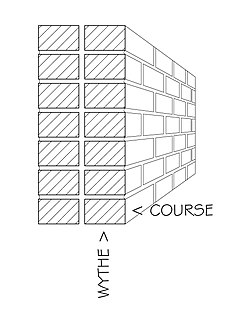Our website is made possible by displaying online advertisements to our visitors.
Please consider supporting us by disabling your ad blocker.
Course (architecture)

A course is a layer of the same unit running horizontally in a wall. It can also be defined as a continuous row of any masonry unit such as bricks, concrete masonry units (CMU), stone, shingles, tiles, etc.[1]
Coursed masonry construction arranges units in regular courses. Oppositely, coursed rubble masonry construction uses random uncut units, infilled with mortar or smaller stones.[1]
If a course is the horizontal arrangement, then a wythe is a continuous vertical section of masonry [2] one unit in thickness. A wythe may be independent of, or interlocked with, the adjoining wythe(s). A single wythe of brick that is not structural in nature is referred to as a masonry veneer.
A standard 8-inch CMU block is exactly equal to three courses of brick.[3] A bond (or bonding) pattern) is the arrangement of several courses of brickwork.[2]
The corners of a masonry wall are built first, then the spaces between them are filled by the remaining courses.[4]
- ^ a b Harris, Cyril (2006). Dictionary of Architecture and Construction (Forth ed.). United States of America. ISBN 978-0071452373.
{{cite book}}: CS1 maint: location missing publisher (link) - ^ a b Ballast, David; O'Hara, Steven (2016). ARE 5 Review Manual for the Architect Registration Exam. United States of America: Professional Publications Inc.
- ^ Cite error: The named reference
Allenwas invoked but never defined (see the help page). - ^ McKee, Harley (1973). Introduction to Early American Masonry. United States: National Trust for Historic Preservation.
Previous Page Next Page


